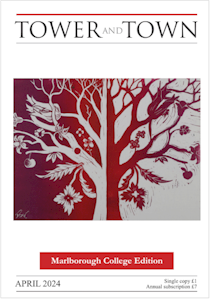

Tower and Town, April 2024 (view the full edition) (view the full edition)How did the geographical position of Venice influence art in the Renaissance?The Renaissance was arguably the most important movement in the history of art and philosophical thinking. It originated in Florence in the fifteenth century led by artists such as Donatello (1385/6-1466), Masaccio (1401-1428) and Leon Battista Alberti (1404-1472), who proposed a return to classical principles. The Renaissance disseminated from Florence to the other Italian city-states and across Europe. Venice was at the forefront of the movement, with the likes of the Bellinis, Giorgione, Titian and Tintoretto all leaving their own distinct mark. Venice's unique geographical and topographical location meant that it was far apart from the rest of Renaissance Italy. The philosopher-poet Francesco Petrarch (1304-74) called it mundus alter, meaning 'another world', situated in north-eastern Italia on the Adriatic Sea, a collection of 118 little islands linked by a labyrinth of bridges and canals in the vast lagoon. Life in Venice differed from that in other city-states such as Florence, which led to its art developing distinct characteristics. Venice's geography ensured it was ideally placed not only to learn the new ideas of the Renaissance, but quickly to establish itself as an important centre of learning. This allowed Venice to develop its own style called venezianitÓ. This was known for its richness of colour, emphasis with light and space, interest in patterns and textures, love for detail and theme of traditional Venetian values. No matter what medium, that of paint, mosaic, stone, marble, wood, ceramic or glass, venezianitÓ meant Venetian art stood out. The Byzantine heritage of Venice introduced eastern traditions to Renaissance art, such as the brilliant colours, texture, and optical effect of light of mosaics. Coarsely woven canvas became the principal support of the Venetian school in the sixteenth century instead of smoothly sanded panels commonly used in Florence. Furthermore, the impasto brushwork on canvas reflected the texture of the mosaic medium. Venice's thriving trade economy meant that its artists were inundated with a wide range of precious and exotic pigments, materials and ideas. They exploited the use of rich colour within their art, most noticeably in the works of Titian. Much-prized ultramarine made from the precious stone lapis lazuli was imported from Afghanistan, azurite or 'German Blue' was transported along ancient routes across the northern Alps and red lakes which are translucent pigments commonly used in the dyeing and textiles industry. These rich pigments resulted in the hues of Venetian art being more sumptuous than those of Florence or Rome. Unlike other cities, as Pero Tafur, a Spaniard who visited Venice in the 1430s, stated "the city has no walls, nor any fortress". Yet Venice's encirclement of the lagoon and domination at sea meant that "if the whole world came against the city, the Venetians could sink a ship between the two castles and canal and be safe". Even mapmaker Benedetto Bordone (1450/55-1530) conveyed the safety of the protective lagoon in his perspective plan of Venice and the Lagoon, from the Isolario di Benedetto Bordone (Venice, 1528). This metaphorically conveys Venice's reassuring safety and strength. The protective lagoon resulted in the political and religious stability that allowed rich artistic tradition to thrive. The extensive marshland provided the city with distinct atmospheric qualities such as the misty and damp environment. The public murals called frescos were one of the central forms of Renaissance art. However, frescos did not survive in the damp climate of Venice. This led to the Venetian artists' main medium being that of oil paint on canvas which could withstand the unique conditions. Furthermore, this everchanging quality in shape and colour by flickering light drove the Venetians' fascination in light and air. The lagoon on the same day could be bright-skied with water clear and glimmering like jewels, to the water later not reflecting but absorbing light, a palette of greys, white, misty blues, and mottled greens. The play of light and air is repeated in their paintings. Venice was built, 'more divine than by human will' commented the diarist Marin Sanudo (1466-1536), upon mud flats. Space was at a premium, as the city's foundations were reliant on the deposition of silt from the flow of irregular tidal currents along the coastline. This meant that unlike other cities, Venice was unable to be evenly divided. Instead, there were six unequal sections called sestieri. Each island self-contained unit with parish church at the centre surrounded by a campo or piazza with houses and shops on the outside. These islands were connected with bridges crossing canals at odd angles. There was asymmetry within a labyrinth of canals and bridges as well as in the buildings such as Piazza San Marco which is trapezoid shaped. This characteristic was reflected in asymmetrical art and counterbalanced composition rooted in their physical surroundings, famously emphasised by Titian in his 'Assuntia' (1518). The geography of Venice undoubtedly contributed to the overall body of Renaissance study through its own unique factors. Ironically these same factors which were so critical in the formation of these ideas now threaten their legacy through the unfortunate combinations of rising sea levels coupled with land subsidence leading to ever more common episodes of flooding. Tilly G (L6; Yr 12) |